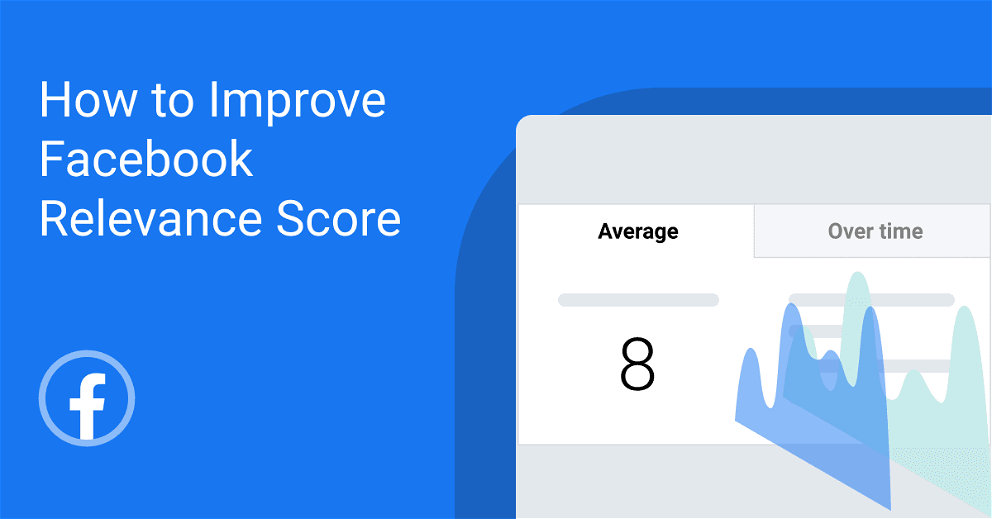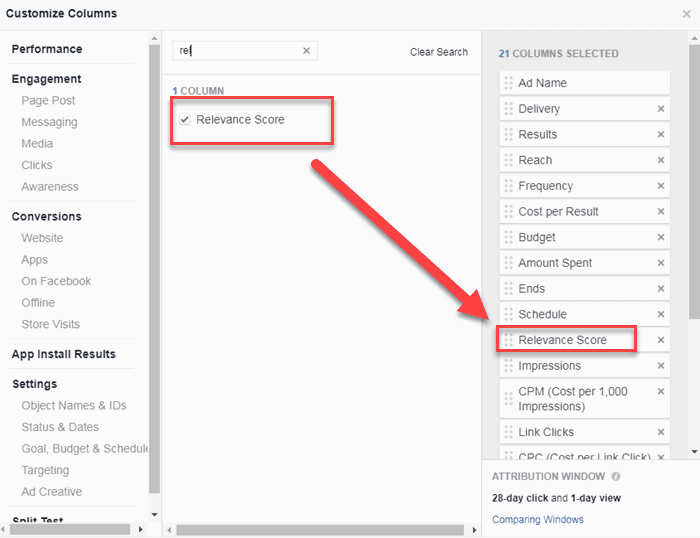How to Improve Facebook Relevance Score
Facebook Relevance Score is a metric that monitors and evaluates Facebook ad quality and engagement to help you understand how relevant your ads are to a specific audience. Facebook determines how well your ads resonate with your audience based on certain factors and rate it with a grade from 1 to 10.

Jan 29 2020 ● 7 min read

Improving your relevance score on Facebook will present your ad in front of the right audience for a lower ad cost, thus increasing your ROI. That’s why you must know how to improve it. Before we reveal eight good strategies that will help you achieve that, you need to understand how Facebook’s relevance score works.
Facebook Relevance Score - Definition and Importance
Once your ad gets 500 impressions, Facebook measures how well it resonated with your target audience based on positive and negative feedback, and rates it with a number from one to ten.
The higher the number, the more Facebook thinks your ad is quality and meaningful for your target audience. As a reward, it lowers the cost per click on Facebook and shows your ad more frequently to the right audience. This, in turn, will increase your ROI.
A low relevance score on Facebook means your ad doesn’t resonate with your target audience, and as a punishment, Facebook increases the ad cost and reduces the frequency of the ad.
How Is Facebook Relevance Score Calculated?
Facebook determines the relevance score of your ad based on the likelihood of your target audience to take the desired action, which is positive feedback. For example, if your campaign’s goal is to generate link clicks, and your target audience generates more link clicks, it means the audience is interested in what you or your ad presents, and your ad receives more positive feedback.
As a result, you’ll get a higher Facebook relevance score, which will increase the frequency of your ad for a lower ad cost and higher ROI – the dream of every advertiser on Facebook.
On the other hand, if your target audience flags or hides your ad, your ad gets negative feedback. It means your target audience is not interested in what your ad presents, which lowers your Facebook relevance score but increases the ad cost.
With relevance score, Facebook makes sure its users are presented with relevant, quality ads, instead of being constantly bombarded with low-quality ads they are not interested in.
What Is a Good Relevance Score on Facebook?
The higher the relevance score, the better. So, a relevance score of 10 is excellent, but anything from 7 to 10 is a good score to aim for.
The worst relevancy score is 1, but any other low number means that your ad doesn’t resonate or barely resonates with your target audience. In that case, it’s best to stop paying Facebook for barely serving your ad to an audience that’s not interested in your ad.
How to See Your Relevance Score on Facebook?
Open your Facebook Ads Manager and go to the Ads tab. Click Columns and choose Customize Columns from the drop-down menu. Use the search bar to look for Positive Feedback, Negative Feedback, and Relevance Score. Add these columns to your view and save the setup.

Now, you can analyze the relevance score of your current ads, as well as their expected level of positive and negative feedback.
8 Ways to Improve Facebook Relevance Score
Here are eight ways to improve your relevance score on Facebook.
1. Shorter Retargeting Windows
The most common retargeting window Facebook advertisers use is 6 months or 180 days. However, this is a long period to see one ad from the same company, especially if you’re constantly retargeting website visitors. Ad fatigue may negatively affect your Facebook relevance score.
Instead, you can use 14 or 30-day retargeting window to achieve better results. To change your retargeting window, go to your Ads Manager and click on Audiences under Assets.
Click on the drop-down arrow on the right and choose Custom Audience. A window will open and you need to choose Website Traffic. Just name the audience, target all website visitors in the last 14 or 30 days, and select Create Audience. Half an hour later, the new audience will be ready for you to retarget.
2. Advertise Lower-Value Offers to Cold Audiences
For a higher relevance score, your ads need to have positive feedback by being interesting enough for your audience for them to take the desired action. So, direct advertising of a $4,000 product or service to cold audiences would generate very few clicks and purchases. As a consequence, your ad will get a negative feedback and a low relevance score.
Therefore, advertising lower-value offers, content, or lead magnet to cold audiences is a better alternative. It allows a lower barrier to entry for your prospects, and a higher chance for them to take the desired action.
3. Use a Published Video on Your Page to Create an Ad
Video ads are often more effective and popular than other Facebook post formats, even though their creation requires more time and money.
If you go with video ads, you must make sure they are of high quality. This may not require shooting in a studio, but a decent lighting and audio quality are a must. If your budget allows you to hire a professional, do it.
If your ad looks like a standard post on Facebook, then chances are you’ll get better results. The purpose of this technique is not to trick your audience, as they will be able to see the sponsored tag by your ad, but to avoid negative feedback.
When it comes to video ads, it’s best to omit a call-to-action button and a headline to prevent them from screaming, “I’m an ad!” So, don’t create a video ad within Facebook Ads Manager, but publish your video to your page on Facebook and use that post to create the ad.
Find and highlight your ad within Facebook Ads Manager, select Edit, and instead of clicking Create Ad, choose Use Existing Post. The next step is finding the post you’ll use as an ad from the drop-down menu and selecting it. Your ad is ready to go.
4. Try Targeting a Larger Audience
Do not over narrow your target audience just because Facebook allows it. This may negatively impact the ad performance and reduce its relevance score.
The first thing Facebook does when you launch a new ad is understanding your target audience and finding out which of them are most likely to take the action you desire – the learning phase. So, if you give Facebook a broader audience to monitor, it will have more scope to discover high-converting segments.
Therefore, try to increase the size of your target audience if the relevance score of your ad is low and your target audience is narrow.
5. Multiple Ad Variations
Ad frequency shows how many times on average a person within your audience has seen your ad. When Facebook ad frequency rises too high, your ads become boring to your audience, your negative feedback increases, and your Facebook relevance score decreases.
How high is too high depends on the type of your target audience. For example, cold audiences don’t tolerate much higher ad frequency numbers than warm audiences.
Usually, when the frequency of ads targeting cold audiences reaches up to 2.5, the Facebook relevance score decreases. In that case, it’s best to make drastic changes to your ad, or target a new audience.
Running many different ads to the same audience at once is an excellent way to fight against this. It will prevent ad fatigue and keep things fresh. Varying the ad creative is especially important when targeting small audiences.
6. Promote Ads to Warm Audience First
Email subscribers, website visitors, video viewers, Facebook page likes, etc., make up a warm audience – people who are familiar with your brand or business.
Your ads will get a much better response if you target these people instead of cold audiences, as they have already interacted with you in the past. Your ad is also more likely to get shared, liked, or commented positively, which will drive social proof that contributes to your ad’s positive feedback and increase your relevance score.
So, before you promote your ads to cold audiences, a good idea is first to promote them to warm audiences.
How to target a warm audience? Find the ad set level of your ad campaign, Audiences, and choose Add a Connection Type within Connections. Click the drop-down arrow on the right and choose People Who Like Your Page.
A good idea is to spend around $5 to promote the ad to your Facebook page to quickly obtain a lot of social proof. After doing this, you can promote it to cold audiences and get better performance and relevance score.
7. Don’t Use Ad Images with a Lot of Text
Even though Facebook may allow over 20% text on your ad image, it doesn’t like it and will negatively impact your reach. As a result, your ad will get less positive feedback, which will reduce its relevance score. Therefore, it’s best to avoid using images that contain more than 20% text.
8. Improve Your Ad’s UVP
UVP is a unique value proposition that stresses what benefits your product or service offers for your target audience. So, make sure your ad includes a good UVP to convince your audience to click it. Click-through-rate will positively impact your ad’s relevance score.
Conclusion
A high Facebook relevance score will show your ad to your target audience more frequently for a lower ad cost. This is how you make a high ROI. So, try as many of these techniques for increasing your Facebook relevance score as possible, and you’ll quickly see an improvement.
Published on Jan 29 2020

WRITTEN BY
Krystyna KrajevskajaKrystyna believes optimizing the way you report data is the key to a good marketing strategy. A seasoned social media manager with experience in B2B companies, she loves to identify and share new business opportunities.

